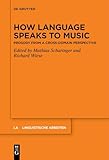How Language Speaks to Music : Prosody from a Cross-domain Perspective / ed. by Mathias Scharinger, Richard Wiese.
Material type: TextSeries: Linguistische Arbeiten ; 583Publisher: Berlin ; Boston : De Gruyter, [2022]Copyright date: ©2022Description: 1 online resource (V, 269 p.)Content type:
TextSeries: Linguistische Arbeiten ; 583Publisher: Berlin ; Boston : De Gruyter, [2022]Copyright date: ©2022Description: 1 online resource (V, 269 p.)Content type: - 9783110770100
- 9783110770254
- 9783110770186
- 808.1
- P311 .H68 2022.
- online - DeGruyter
- Issued also in print.
| Item type | Current library | Call number | URL | Status | Notes | Barcode | |
|---|---|---|---|---|---|---|---|
 eBook
eBook
|
Biblioteca "Angelicum" Pont. Univ. S.Tommaso d'Aquino Nuvola online | online - DeGruyter (Browse shelf(Opens below)) | Online access | Not for loan (Accesso limitato) | Accesso per gli utenti autorizzati / Access for authorized users | (dgr)9783110770186 |
Frontmatter -- Contents -- Introduction: How to conceptualize similarities between language and music -- Pitch units in music and speech prosody -- Melody in speech and music -- A constraint-based approach to structuring language and music: Towards a roadmap for comparing language and music cross-culturally -- Word stress perception by congenital amusics -- Rhythmic structure – parallels between language and music -- Alignment of prosodic weight and musical length in Finnish vocal music textsetting -- Metrical mapping in text-setting: Empirical analysis and grammatical implementation -- Prominence alignment in English and Turkish songs: Implications for word prosodic typology -- Bridging speech and music – A neural common ground perspective on prosody -- Index
restricted access online access with authorization star
http://purl.org/coar/access_right/c_16ec
Prosody as a system of suprasegmental linguistic information such as rhythm and intonation is a prime candidate for looking at the relation between language and music in a principled way. This claim is based on several aspects: First, prosody is concerned with acoustic correlates of language and music that are directly comparable with each other by their physical properties such as duration and pitch. Second, prosodic accounts suggest a hierarchical organization of prosodic units that not only resembles a syntactic hierarchy, but is viewed as (part of) an interface to syntax. Third, prosody provides a very promising ground for evolutionary accounts of language and music. Fourth, bilateral transfer effects between language and music are best illustrated on the level of prosody. Highlighting the first two aspects, this book shows that it is a fruitful endeavor to use prosody for a principled comparison of language and music. In its broader sense, prosody as sound structure of communicative systems may be considered a »meta«-language that formalizes the way of "how music speaks to language and vice versa". Prosody is firmly established within linguistic theory, but is also applied in the musical domain. Therefore, prosody is not just a field of inquiry that shares elements or features between music and language, but can additionally provide a common conceptual ground.
Issued also in print.
Mode of access: Internet via World Wide Web.
In English.
Description based on online resource; title from PDF title page (publisher's Web site, viewed 25. Jun 2024)


